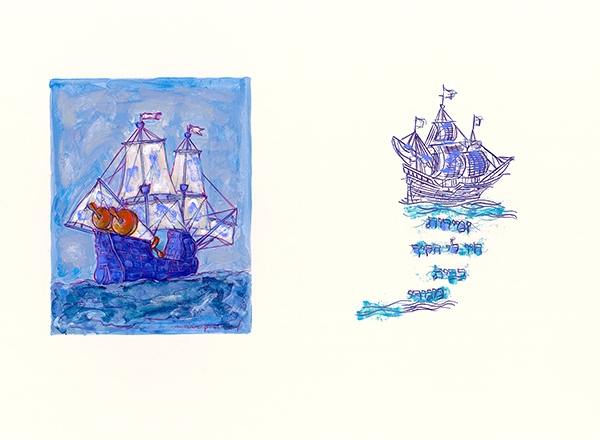Artist and Physician Mark Podwal’s Beautiful Images Tell of Painful Jewish History

MIDDLEBURY, Vt. – In the stark opening moments of the short documentary film All This Has Come Upon Us…, artist Mark Podwal stands outside the looming gates of Auschwitz. Addressing the viewer directly, he says that the humiliations, persecutions, and massacres of Jews by Nazi Germany all had their precedence in the Middle Ages, including ghettos, distinctive clothing, slaughters, and exiles in Europe. In comparison with the magnitude of the Holocaust, these earlier sufferings tend to be forgotten, Podwal says.
A dermatologist and faculty member at the New York University School of Medicine, Podwal spoke and presented the film and samples of his artwork before an audience of faculty, staff, and students at the Axinn Center on Thursday evening. The film, produced by Czech TV and aired on the 70th anniversary of the liberation of Auschwitz, depicts Podwal’s creative process in his most recent artwork.
In tandem with his distinguished work in medicine, Podwal has carried on an astonishing second career as a painter and illustrator–with no formal training–whose work appears in permanent collections around the world, including the Metropolitan Museum of Art, the Library of Congress, and the Holocaust Memorial Museum. He has published 11 of his own books and illustrated 19 others, including collaborations with the author Elie Wiesel. His drawings have appeared frequently on the opinion pages of the New York Times.
Shortly into the film, Podwal is seen entering a hidden synagogue in the former Terezin concentration camp outside of Prague. He reads from timeworn Hebrew lettering on an inside wall, which translates to “Yet despite all this, we have not forgotten your name.” This, he says, is the premise for a 42-piece exhibition he created for the Terezin Ghetto Museum in 2014 and for which the film is named. Podwal donated one of the few limited editions of this collection–published as archival pigment prints–to Middlebury’s Special Collections and Archives.
Each artwork in the Terezin collection appears as a page from a book, with a drawing or painting on the left and a verse from the Book of Psalms on the facing page. An art critic for the Atlantic once described Podwal’s work as “deceivingly abstract and playfully colorful, yet it’s just as powerful in depicting the history of injustice.” Podwal himself described the beautiful and biting pieces as “depicting the history of the Jewish people–their suffering and their misfortunes–which occurred throughout the centuries.”
Throughout the film it becomes clear that Podwal’s true artistic gift is his ability to translate complex, often painful, concepts into beautiful, thought-provoking visuals. The author Namoi Patz describes him in the film as “having special insights that I think other people don’t seem to have. He looks at something and sees more than is there, and brings into what is there information and understanding and insight that helps to expand the piece he is drawing.”
Podwal said that the request to create an exhibition for the Terezin museum came unexpectedly, but that it did not take him long to figure out an approach. “I thought the best thing to do would be to portray the path of the many, many precedents [of the Holocaust] that people are not aware of.” The scale of suffering in the Middle Ages, he says, was smaller than the mechanized killing of the Holocaust, yet the injustices were extreme. As one of many examples, he noted that from 1348-49, Jews were accused of spreading the Black Death by poisoning wells, and entire Jewish communities were destroyed as a result.
Despite the grim nature of his Terezin work, Podwal assured the audience that he does not only focus on the history of pain experienced by the Jewish people. In recent years he has done exhibitions on Jewish holidays and festivals. He continues to design posters for the Metropolitan Opera seasons, and has done numerous projects with the Metropolitan Museum of Art, including jewelry designs and prints. He is currently working on a series of paintings on Mozart and Prague, which he described as “a much cheerier subject.”
With reporting by Stephen Diehl; Photos by Todd Balfour

